To understand the Van de Graaff generator and how it works, you need to understand static electricity. Almost all of us are familiar with static electricity because we can see and feel it in the winter. On dry winter days, static electricity can build up in our bodies and cause a spark to jump from our bodies to pieces of metal or other people's bodies. We can see, feel and hear the sound of the spark when it jumps.
In science class you may have also done some experiments with static electricity. For example, if you rub a glass rod with a silk cloth or if you rub a piece of amber with wool, the glass and amber will develop a static charge that can attract small bits of paper or plastic.
To understand what is happening when your body or a glass rod develops a static charge, you need to think about the atoms that make up everything we can see. All matter is made up of atoms, which are themselves made up of charged particles. Atoms have a nucleus consisting of neutrons and protons. They also have a surrounding "shell" that is made up electrons. Typically, matter is neutrally charged, meaning that the number of electrons and protons are the same. If an atom has more electrons than protons, it is negatively charged. If it has more protons than electrons, it is positively charged.
Some atoms hold on to their electrons more tightly than others do. How strongly matter holds on to its electrons determines its place in the triboelectric series. If a material is more apt to give up electrons when in contact with another material, it is more positive in the triboelectric series. If a material is more apt to "capture" electrons when in contact with another material, it is more negative in the triboelectric series.
The following list describes the triboelectric series for many materials you find around the house. Positive items in the series are at the top, and negative items are at the bottom:
- Human hands (usually too moist, though) Very positive
- Rabbit fur
- Glass
- Human hair
- Nylon
- Wool
- Fur
- Lead
- Silk
- Aluminum
- Paper
- Cotton
- Steel Neutral
- Wood
- Amber
- Hard rubber
- Nickel, Copper
- Brass, Silver
- Gold, Platinum
- Polyester
- Styrene (Styrofoam)
- Saran Wrap
- Polyurethane
- Polyethylene (like Scotch Tape)
- Polypropylene
- Vinyl (PVC)
- Silicon
- Teflon Very negative
(The above list is adapted from the book Nature's Electricity by Charles K. Adams.)
The relative position of two substances in the triboelectric series tells you how they will act when brought into contact. Glass rubbed by silk causes a charge separation because they are several positions apart in the table. The same applies for amber and wool. The farther the separation in the table, the greater the effect.
When two non-conducting materials come into contact with each other, a chemical bond, known as adhesion, is formed between the two materials. Depending on the triboelectric properties of the materials, one material may "capture" some of the electrons from the other material. If the two materials are now separated from each other, a charge imbalance will occur. The material that captured the electron is now negatively charged and the material that lost an electron is now positively charged. This charge imbalance is where "static electricity" comes from. The term "static" in this case is deceptive, because it implies "no motion," when in reality it is very common and necessary for charge imbalances to flow. The spark you feel when you touch a door knob is an example of such flow.
In the next section we'll look at the many factors that affect the size of a static electricity shock.


